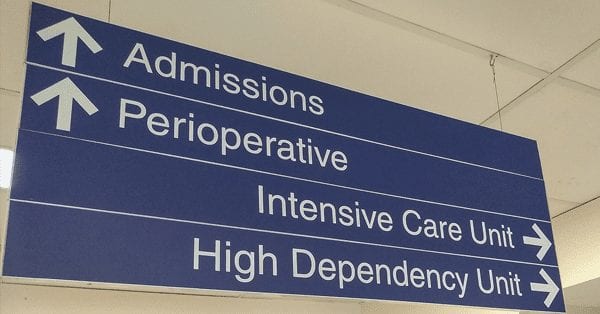Hospitals are working to drive down 30-day readmission rates for the benefit of patients, and to avoid reimbursement cuts by the Centers for Medicare and Medicaid (CMS). In our third post on the impact of the Hospital Readmission Reduction Program (HRRP), we discuss:
- Where patients with conditions associated with HRRP penalties are admitted to the hospital
- And, where patients turn-up when they experience complications after an inpatient stay – it’s the Emergency Department (ED), of course.
Which HRRP conditions are most associated with admission from the ED?
Adult patients admitted from the ED account for about 70% of all hospital admissions. Your hospital is more likely to see patients arrive in the ED when the community you serve has a high percentage of patients with:
- Chronic comorbidities
- Heart disease
- Heavy alcohol use
- Kidney failure
- Smoking rates
In addition, an older population is a significant indicator of an increased risk of hospitalization. Communities with patients over 65 years old are three times more likely to be hospitalized for pneumonia. More elderly patients are hospitalized due to heart failure than both heart attacks and pneumonia combined. Heart failure is also the number one cause of hospitalization.
With this in mind, we took a look at initial patient admissions from the emergency room related to:
- Acute Myocardial Infarction (AMI)
- Chronic Obstructive Pulmonary Disease
Patients with symptoms of AMI frequently arrive in the ED
Six million patients with chest pain or AMI related symptoms turn up in the emergency room each year. About 12% of those patients are admitted. How can you prevent readmissions at the time of admission? Improve the quality of diagnosis and treatment decisions.
FYI: Patients released from the ED
As a side note, patients that are released from the ED but are later diagnosed with AMI are typically:
- Women under the age of 55,
- Not Caucasian,
- Or have atypical symptoms
Most patients with symptoms of narrowed or blocked arteries that are considered atypical are older. These patients frequently do not have chest pain, which is referred to as silent ischemia. It’s important to pay extra attention to those patients over 60 that show up in the ED without chest pain but have other indicators of heart failure, like high cholesterol and blood pressure combined with fatigue, neck or jaw pain, nausea or shortness of breath.
Hospitals serving communities with less than 50,000 people are more likely to release patients with AMI that should be admitted.
About 1.5 million COPD patients visit the emergency room each year
Aggravation or worsening symptoms occur 1-3 times each year for most patients diagnosed with COPD. More than 16 million people in the U.S. have been diagnosed with COPD. The number of visits these patients make to the ED is closely associated with both the mortality and cost of care.
Frequent aggravation of COPD symptoms brings the patient to the emergency room, and the frequency of exacerbation drives up the likelihood of both admission and mortality. Focusing on appropriate long-term and short-term care can prevent admission – and readmission – of these patients. Unlike many of the patients with conditions that drive HRRP penalties, most patients suffering from COPD have insurance coverage.

The Journal of the COPD Foundation reported that more than 90% of these patients have insurance. However, many are reluctant to visit the doctor. Hospitals can disrupt ED visits by COPD patients by focusing on proper diagnosis in the ED and outpatient follow-up. Telemedicine can help by providing access to board-certified pulmonologists in the emergency department, and in outpatient clinics.
Other conditions related to CMS penalties, like pneumonia and heart failure, also drive patients to the ED and lead to a high number of unnecessary admissions and readmissions. It’s not just about AMI admissions. Each year, more than 600,000 patients suffering from heart failure visit the emergency department.
Can Better Diagnoses Help with Hospital Readmission Reduction Program Initiatives?

One study of the HRRP program showed that initial admission rates of patients with heart failure or pneumonia contributed more to the regional variation in readmission rates than indicators like case mix, discharge planning and hospital size.
For example, 80% of emergency room visits lead to a discharge but 80% of patients with acute heart failure that arrive in the emergency room are admitted. Yet, many of these patients present with low-risk factors that would permit discharge.
Consults with a telemedicine specialist, like a TeleCardiologist or TelePulmonologist, reduce the overall time the patient spends in the emergency department as well as the wait time for a diagnosis. The same study also suggested that these consultations likely reduced heart attack risk.
Knowing which patients to keep is critical to providing appropriate care, limiting unnecessary admission, and preventing readmissions after an inpatient stay. Let’s take a look at how the ED can reduce readmission rates without putting patients at higher risk.
Not all readmissions are will contribute to HRRP penalties and 30-day readmission rates
Many readmissions are not related to the conditions that are the focus of HRRP, like pneumonia, COPD and heart failure. Unassociated readmissions are often caused by:
- Medication errors and noncompliance
- Injuries associated with falls
- Inadequate transportation or access to follow-up care
- Conditions that are not monitored by HRRP, including neoplasms, blood diseases, infections and mental health disorders
What’s the takeaway? Some readmissions are preventable or can be mitigated by outpatient initiatives, like medication noncompliance and access to follow-up care. Others are impacted by underlying health problems that are not often within the hospital’s scope of control. For example, readmissions related to neoplasms are commonly associated with cancer.
There is no doubt that patients needing inpatient care should be admitted or readmitted regardless of where the admission takes place. The safety of the patient comes first – before any financial penalty is considered.
Access Specialists Can Help Reduce 30-Day Readmission Rates & Penalties
While we never want to see a patient discharged from the ED simply to avoid penalties, there are things that emergency staff can do to successfully discharge patients. Get a 2nd Opinion!
In one analysis of 30-day readmission rates for pneumonia, researchers found two variables impacted avoidable readmission – status as a teaching hospital and the number of reviewers per case.
While it’s nearly impossible to convert a nonteaching hospital to an academic facility, adding another reviewer to the case of a possible pneumonia readmission is both accessible, particularly when using telemedicine, and financially practical.
Avoiding a reduction in payment of up to 3% is sufficient justification for the additional case review. If your hospital is at risk of a CMS payment adjustment, adding a reviewer is incentivized by the program. In this situation, your hospital’s payment adjustment won’t apply to only patients suffering from pneumonia. CMS will “apply the payment adjustment factor for all discharges in the applicable fiscal year, no matter the condition.”
Decision-making in the emergency department was one of three factors most associated with preventable 30-day readmission rates. In hospitals with no access to specialists or only daytime specialist coverage, consulting with a telemedicine provider can support better decision-making in the ED.
Evaluation of returning cardiology patients can also be improved by including a consult between the emergency medicine provider and a specialist. Heart failure consistently accounts for approximately 20% of all 30-day readmission patients.
In response to both the high level of readmissions and the HRRP, many clinical interventions were tested to reduce the rate of cardiology related readmission.
An article in the October 14, 2019 publication of the BMJ Open Quality Journal, reported that clinical outcomes for patients with heart failure are better when a patient is treated by a cardiologist. The article also reported a reduction in hospital admissions and observation visits when a cardiologist is consulted.
More broadly, a Journal of Hospital Medicine reported study showed that 30-day readmission rates are often driven by provider practice patterns and hospital care systems. The average readmission rate following an emergency room visit is slightly more than 50%. However, provider readmission rates deviated widely from the overall mean – 14% of providers readmitted patients more than 67% of the time. Conversely, almost 15% of providers readmitted patients about 37% of the time.
When the authors of this study evaluated the wide range of readmission rates, the facility also had an impact. While the study did not identify a specific cause for the variation, the authors suggest that a few factors may drive the variation:
- Providers with similar practice patterns working in the same facility
- Absence of, or minimal clinical guidance for when to readmit a patient with a specific condition
- Patient populations with low-income areas or without access to primary care
Here again, telemedicine can support the resolution of some of these factors by:
- Providing risk-adverse or tolerant providers with the opportunity to consult with a specialist to determine the best course of action for a particular patient case.
- Support the development of clinical guidance and best practices within your emergency department.
Hospitals across the country are also developing processes that flag patients who would qualify as a 30-day readmission case. Identification of these patients in the EMR can help emergency medicine providers know when to request a specialist consult or second opinion.
Preventing readmissions requires hospitals to consider both the diagnosis at the time of initial admission and when a patient returns to the ED after an inpatient hospital stay. telemedicine consults can support decisions by emergency medicine providers that are in the best interest of the patient and reduce the risk of readmission.
Read more about how telemedicine can reduce readmissions:
- Should hospitals increase access to specialists to lower hospital readmissions?
- Can better diagnoses, prescriptions help with hospital readmission reduction program initiatives?
- What’s the impact of physician burnout on readmission rates?
- Will improved discharge procedures lower hospital readmission rates?
- Can reducing hospital patient transfer lower readmission rates?







